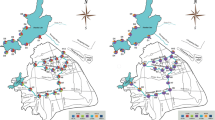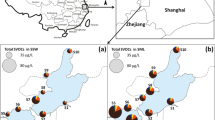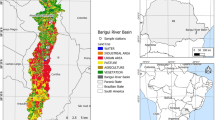Abstract
Concentration of dissolved aromatic and halogenated non-methane volatile organic compounds (NMVOCs) was estimated in sewage flowing through the open drainage canal network of Kolkata megacity in India in dry (summer) and wet (post-monsoon) seasons at five locations. Seventeen aromatic and halogenated NMVOC species were studied by headspace solid-phase micro-extraction (HS-SPME) technique followed by gas chromatography–mass spectrometric (GC–MS) analysis. Distinct seasonal variations in the concentration of individual NMVOC species were observed, but spatial variation was negligible. Total dissolved NMVOC (TNMVOC) concentration was higher (16.64 µg l − 1) in summer over post-monsoon (12.70 µg l − 1). Chloroform and toluene were the most abundant species in both seasons. Principal component analysis indicated contribution from industrial sources (38.8% and 35.5%), solvent usage (35.9% and 35.5%), in situ formation through microbial pathways (22.2% and 11.5%) in dry and wet seasons, respectively. Contribution by gasoline (12.3%) was found in post-monsoon only, possibly due to higher mixing of city's stormwater carrying gasoline residues from roads, garages, and commercial areas. The dynamic load of all quantified NMVOCs combined in the entire canal network was estimated to be 182.2 and 162.0 kg in summer and post-monsoon, respectively. The likely distribution of a few prominent NMVOC species in different environmental compartments, simulated by multimedia mass balance model TaPL3 (3.0), showed that almost the entire dissolved chloroform would be emitted to atmosphere (98%), followed by benzene (71%), in contrast to xylene that would primarily get partitioned into canal sediment (53%). Toluene showed the highest likely atmospheric emission from canal water in summer (63.55 kg), whereas in post-monsoon, chloroform had the highest possible release (48.12 kg) into the atmosphere.




Similar content being viewed by others
Data availability
The datasets generated during and/or analyzed during the current study are available from the corresponding author on reasonable request.
References
APHA (2005) Standard method for examination of water and wastewater, American Public Health Association, American Water Works Association, Water Environment Federation. 21st Edition
ATSDR (2016) Review and analysis of volatile organic compounds (VOCs) and metal exposures in air. Agency for Toxic Substances and Disease Registry. (https://www.atsdr.cdc.gov/)
Attri SD, Singh S, Mukhopadhyay B, Bhatnagar AK (2008) Atlas of hourly mixing height and assimilative capacity of atmosphere in India. India Meteorological Dept., New Delhi, India
Bell JP, Osinga I, Melcer H (Henryk) (1988) Investigation of stripping of volatile organic contaminants in municipal wastewater treatment systems. Ontario Ministry of the Environment, ISBN 0–7729–4720–1
Bell J, Melcer H, Monteith H, Osinga I, Steel P (1993) Stripping of volatile organic compounds at full-scale municipal wastewater treatment plants. Water Environ Res 65(6):708–716
Beyer A, Mackay D, Matthies M, Wania F, Webster E (2000) Assessing long range transport potential of persistence organic pollutants. Environ Sci Technol 34:699–703
Bhattacharjee C (2014) Canals and its relevance to the Kolkata mega city. Abhinav 3(5):20–24
Bianchi AP, Varneyf MS (1997) Volatilisation processes in wastewater treatment plants as a source of potential exposure to VOCs. Ann Occup Hyg 41(4):437–454
Carter WPL (1990) A detailed mechanism for the gas-phase atmospheric reactions of organic compounds. Atmos Environ Part A General Topics 24(3):481–518
Chahar BR (2005) Optimal design of parabolic canal section. J Irrig Drain Engg 131(6):546–554
Chen WH, Lin SJ, Lee FC, Chen MH, Yeh TY, Kao CM (2017) Comparing volatile organic compound emissions during equalization in wastewater treatment between the flux-chamber and mass-transfer methods. Proc Safety Environ Protect 109:410–419
Cheng WH, Hsu SK, Chou MS (2008) Volatile organic compound emissions from wastewater treatment plants in Taiwan: Legal regulations and costs of control. J Environ Manag 88(4):1485–1494
van Chow T (1959) Open-Channel Hydraulics. McGraw-Hill, New York, p 680
Costa AS, Romão LPC, Araújo BR, Lucas SCO, Maciel STA, Wisniewski Jr. A, Alexandre MR (2012) Environmental strategies to remove volatile aromatic fractions (BTEX) from petroleum industry wastewater using biomass. Biores Technol 31–39
Christopher JQ, Corsi RL (1995) Emissions of VOCs from a municipal sewer. J Air Waste Manag Assoc 45(5):395–403
Escalas A, Guadayol JM, Cortina M, Rivera J, Caixach J (2003) Time and space patterns of volatile organic compounds in a sewage treatment plant. Water Res 37:3913–3920
Fatone F, Di Fabio S, Bolzonella D, Cecchi F (2011) Fate of aromatic hydrocarbons in Italian municipal wastewater systems: an overview of wastewater treatment using conventional activated-sludge processes (CASP) and membrane bioreactors (MBRs). Water Res 45:93–104
Gasperi J, Garnaud S, Rocher V, Moilleron R (2008) Priority pollutants in wastewater and combined sewer overflow. Sci Total Environ 407:263–272
Gavalda A (2000) Personal communication from Albert Gavald, aroma expert from Aromas Maluquer SA, Saragossa 91, 08912 Badalona, Spain, 2000
Harkov R, Jenks J, Ruggeri C (1987) Proceedings Annual Meeting, Air Pollution Control Association; (USA); Journal Volume: 6; Conference: 80. annual meeting of the Air Pollution Control Association, New York, NY (USA), 21–26 Jun; Technical Paper 87–95
IS 1982. Tolerance limits for inland surface water subject to pollution. IS: 2296–1982
Juttner F (1988) Benzene in the anoxic hypolimnion of a freshwater lake. Naturwissenschaften 75:151–153
Majumdar D (2020) How are the two most polluted metro-cities of India combating air pollution? Way Forward after Lifting of COVID-19 Lockdown. Aerosol Air Qual Res 21(1):200463
Majumdar D, Srivastava A (2012) Volatile organic compound emissions from municipal solid waste disposal sites: a case study of Mumbai. J Air Waste Manag Assoc 62(4):398–407
Majumdar D, Gavane AG (2020) Diurnal-, seasonal- and site-dependent variability in ground-level total non-methane hydrocarbon in Nagpur City of Central India. Asian J Atmos Environ 14(1):1–13
Majumdar D, Rao PS, Chakraborty BD, Srivastava A (2015) Effects of unregulated anthropogenic activities on mixing ratios of volatile organic air pollutants-a case study. J Air Waste Manag Assoc 65(9):1094–1103
Majumdar D, Purohit P, Bhanarkar AD, Rao PS, Rafaj P, Amann M, Sander R, Pakrashi A, Srivastava A (2020) Managing future air quality in megacities: emission inventory and scenario analysis for the Kolkata Metropolitan City, India. Atmos Environ 222:117135
Majumdar D, Mondal R, Periyasamy A, Barman N, Dey S, Roy S, Mandal P, Rao PS, Sarkar U (2021) Characterization and sources of fine carbonaceous aerosol in winter over a megacity on Indo-Gangetic plain. Urban Clim 39:100964
Mazzeo DEC, Levy CE, de Franceschi de Angelis D, Marin-Morales MA (2010) BTEX biodegradation by bacteria from effluents of petroleum refinery. Sci Total Environ 408(20):4334–4340
Mitra S, Roy P (2011) BTEX: a serious ground-water contaminant. Res J Environ Sci 5(5):394–398
Namkung E, Ritimann BE (1987) Estimating volatile organic compound emissions from publicly owned treatment works. J Water Poll Cont Fed 59:670
Nikolaou AD, Golfinopoulos SK, Kostopoulou MN, Kolokythas GA, Lekkas TD (2002) Determination of volatile organic compounds in surface waters and treated wastewater in Greece. Water Res 36:2883–2890
Parra MA, González L, Elustondo D, Garrigó J, Bermejo R, Santamaría JM (2006) Spatial and temporal trends of volatile organic compounds (VOC) in a rural area of Northern Spain. Sci Total Environ 370:157–167
Paul A (2009) Assessment of waterlogging in CMC and its social impact. Ph.D. Thesis, University of Calcutta, West Bengal, India, 429 p (http://hdl.handle.net/10603/154829)
Paxeus N (1996) Vehicle washing as a source of organic pollutants in municipal wastewater. Water Science Technol 33(6):1–8
Pellizzari ED (1982) Volatile organics in aeration gases at municipal treatment plants. EPA-600/52–82–056, USEPA, Cincinnati
Som D, Dutta C, Chatterjee A, Mallick D, Jana TK, Sen S (2007) Studies on commuters’ exposure to BTEX in passenger cars in Kolkata, India. Sci Total Environ 372:426–432
Srivastava A, Majumdar nèe Som D (2010) Emission inventory of evaporative emissions of VOCs in four metro cities in India. Environ Monit Assess 160(1–4):315–322
Srivastava A, Som D (2007) Hazardous air pollutants in industrial area of Mumbai – India. Chemosphere 69:458–468
Suschka J, Mrowiec B, Kuszmider G (1996) Volatile organic compounds (voc) at some sewage treatment Plants in Poland. Wat Sci Tech 33(12):273–276
Webster E, Mackey D, Wania F (1998) Evaluating Environmental Persistence. Environ Toxicol Chem 17:2148–2158
WEF-ASCE (1995) toxic air emissions from wastewater treatment facilities. Water Environment Federation-American Society of Civil Engineers, Alexandria
Yang J, Wang K, Zhao Q, Huang L, Yuan C-S, Wei-Hsiang C, Wen-Bin Y (2014) Underestimated public health risks caused by overestimated VOC removal in wastewater treatment processes. Environ Sci Process Impacts 16:271
Zhang Y, Zang T, Yan B, Wei C (2020) Distribution characteristics of volatile organic compounds and contribution to ozone formation in a coking wastewater treatment plant. Int J Environ Res Public Health 17:553
Zytner RG (1994) Sorption of benzene, toluene, ethylbenzene and xylenes to various media. J Hazard Mat 38:113–126
Acknowledgements
The authors gratefully acknowledge the support of the Director, CSIR-NEERI. The manuscript has been cross-checked for similarity index by iThenticate software at KRC (Knowledge Resource Centre) of CSIR-National Environmental Engineering Research Institute. The number assigned to the manuscript is CSIR-NEERI/KRC/2020/AUG/KZC/1.
Funding
The authors declare that this research did not receive any specific grant from funding agencies in the public, commercial, or not-for-profit sectors. The study was conducted with institutional resources of CSIR-National Environmental Engineering Research Institute, Kolkata Zonal Center.
Author information
Authors and Affiliations
Contributions
Both authors contributed to the study conception and design. Material preparation, data collection, and analysis were performed by Deepanjan Majumdar and Dipanjali Majumdar. The first draft of the manuscript was written by Deepanjan Majumdar and both authors commented on previous versions of the manuscript. Both authors read and approved the final manuscript. Both authors contributed equally in this manuscript.
Corresponding author
Ethics declarations
Informed consent
Not applicable.
Consent to participate
Not applicable.
Consent for publication
Not applicable.
Competing interests
The authors declare no competing interests.
Research involving human participants and/or animals
This research did not involve any human participants and/or animals.
Additional information
Responsible Editor: Ester Heath
Publisher's note
Springer Nature remains neutral with regard to jurisdictional claims in published maps and institutional affiliations.
Supplementary Information
Below is the link to the electronic supplementary material.
Rights and permissions
About this article
Cite this article
Majumdar, D., Majumdar, D. Dissolved load of aromatic and halogenated non-methane VOCs in urban sewage during wet and dry seasons. Environ Sci Pollut Res 29, 60289–60301 (2022). https://doi.org/10.1007/s11356-022-19924-2
Received:
Accepted:
Published:
Issue Date:
DOI: https://doi.org/10.1007/s11356-022-19924-2




